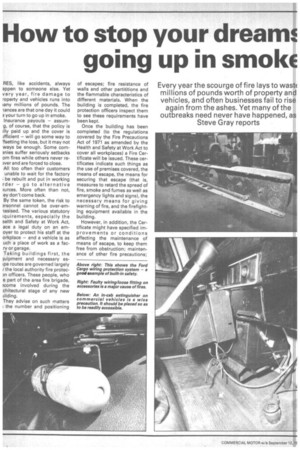How to stop your dreamt going up in smoke
Page 34

If you've noticed an error in this article please click here to report it so we can fix it.
Every year the scourge of fire lays to wast( millions of pounds worth of property and vehicles, and often businesses fail to rise again from the ashes. Yet many of the outbreaks need never have happened, as Steve Gray reports
RES, like accidents, always appen to someone else. Yet very year, fire damage to ,operty and vehicles runs into any millions of pounds. The lances are that one day it could 9 your turn to go up in smoke. Insurance payouts — assumg, of course, that the policy is !Ily paid up and the cover is ifficient — will go some way to Isetting the loss, but it may not ways be enough. Some corn3nies suffer seriously setbacks ern fires while others never reAter and are forced to close.
All too often their customers unable to wait for the factory ! be rebuilt and put in working rder — go to alternative )urces. More often than not, ey don't come back.
By the same token, the risk to arsonnel cannot be over-emlasised. The various statutory !quirements, especially the aalth and Safety at Work Act, ace a legal duty on an emoyer to protect his staff at the orkplace — and a vehicle is as uch a place of work as a facry or garage.
Taking buildings first, the iuipment and necessary esipe routes are governed largely the local authority fire protec)n officers. These people, who e part of the area fire brigade, come involved during the chitectural stage of any new of escapes; fire resistance of walls and other partititions and the flammable characteristics of different materials. When the building is completed, the fire protection officers inspect them to see these requirements have been kept.
Once the building has been completed (to the regulations covered by the Fire Precautions Act of 1971 as amended by the Health and Safety at Work Act to cover all workplaces) a Fire Certificate will be issued. These certificates indicate such things as the use of premises covered, the means of escape, the means for securing that escape (that is, measures to retard the spread of fire, smoke and fumes as well as emergency lights and signs), the necessary means for giving warning of fire, and the firefighting equipment available in the building.
However, in addition, the Certificate might have specified improvements or conditions affecting the maintenance of means of escape, to keep them free from obstruction; maintenance of other fire precautions;








































































